Leadership and Management in Business: Roles, Theories, and Practice
VerifiedAdded on 2021/02/20
|17
|5691
|21
Report
AI Summary
This report provides a comprehensive analysis of leadership and management concepts, focusing on the distinctions between leaders and managers, their respective roles, and characteristics. It explores the application of leadership and management functions in various business situations, emphasizing the importance of adapting leadership styles to changing circumstances. The report delves into different leadership theories, including situational and system leadership, providing insights into their strengths and weaknesses. Furthermore, it examines the relationship between leadership and management in the context of operation management and achieving business goals, using Corus, a steel company, as a case study. The report concludes by assessing the factors within the business environment that influence leadership and management practices, offering a holistic view of the subject.
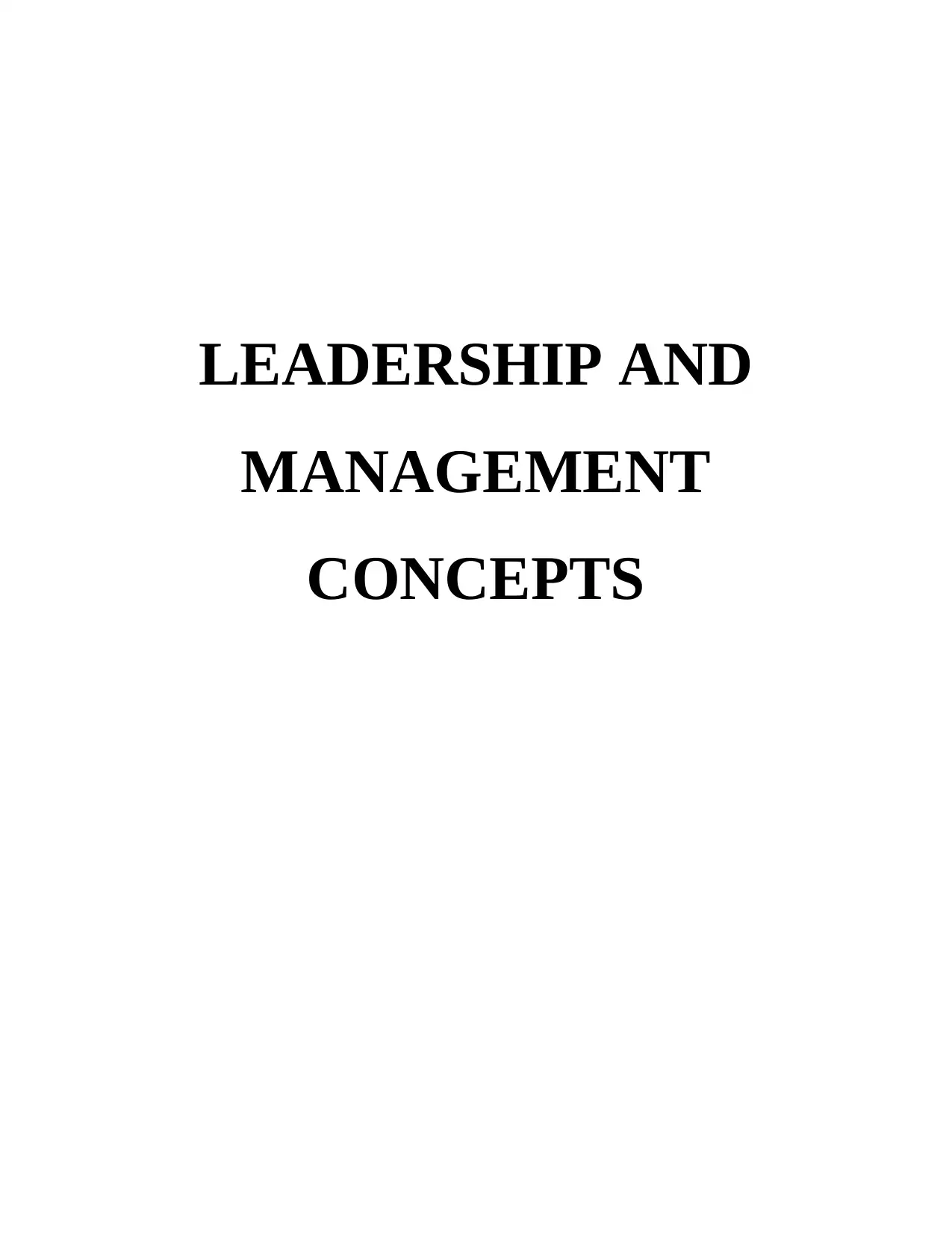
LEADERSHIP AND
MANAGEMENT
CONCEPTS
MANAGEMENT
CONCEPTS
Paraphrase This Document
Need a fresh take? Get an instant paraphrase of this document with our AI Paraphraser
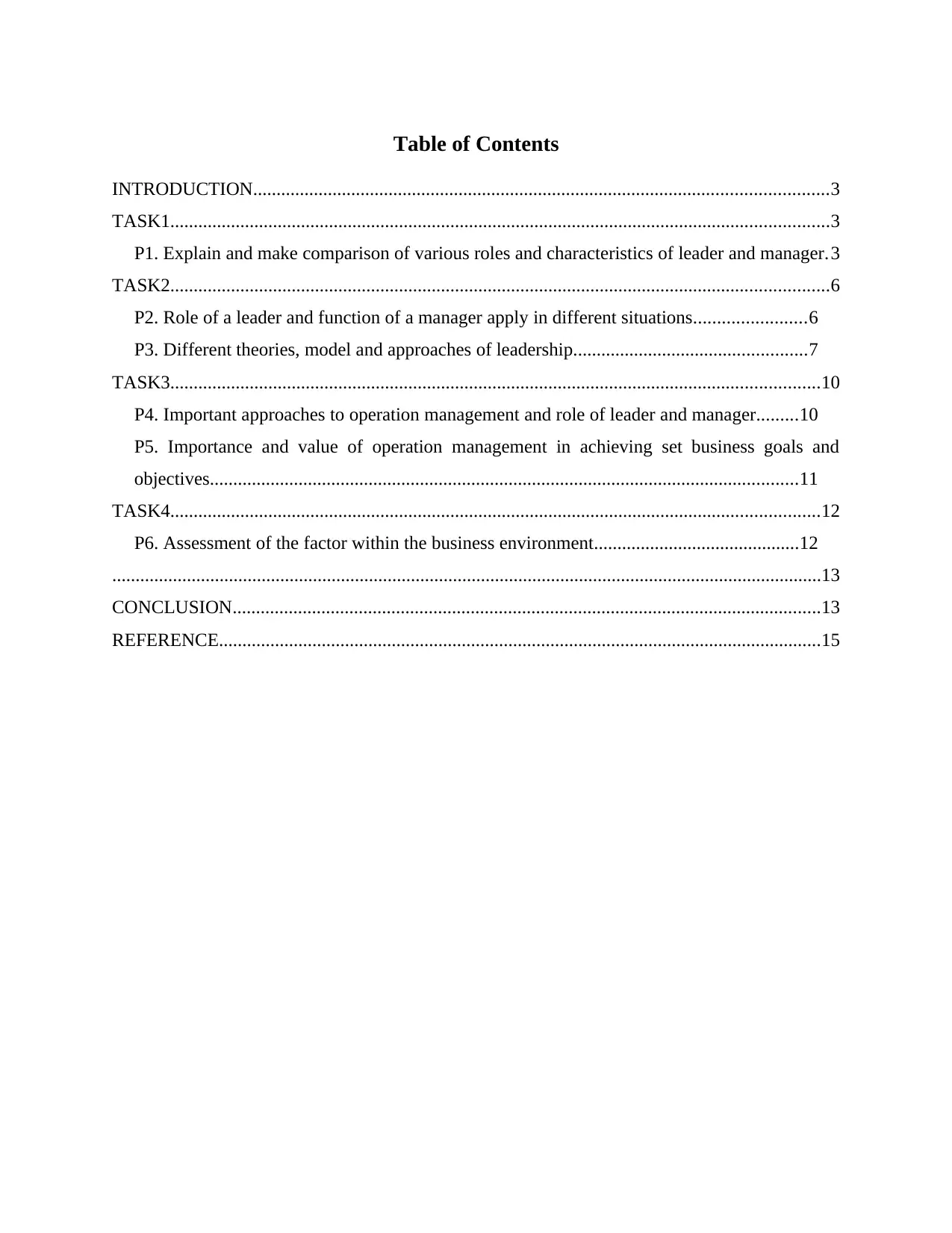
Table of Contents
INTRODUCTION...........................................................................................................................3
TASK1.............................................................................................................................................3
P1. Explain and make comparison of various roles and characteristics of leader and manager.3
TASK2.............................................................................................................................................6
P2. Role of a leader and function of a manager apply in different situations........................6
P3. Different theories, model and approaches of leadership..................................................7
TASK3...........................................................................................................................................10
P4. Important approaches to operation management and role of leader and manager.........10
P5. Importance and value of operation management in achieving set business goals and
objectives..............................................................................................................................11
TASK4...........................................................................................................................................12
P6. Assessment of the factor within the business environment............................................12
........................................................................................................................................................13
CONCLUSION..............................................................................................................................13
REFERENCE.................................................................................................................................15
INTRODUCTION...........................................................................................................................3
TASK1.............................................................................................................................................3
P1. Explain and make comparison of various roles and characteristics of leader and manager.3
TASK2.............................................................................................................................................6
P2. Role of a leader and function of a manager apply in different situations........................6
P3. Different theories, model and approaches of leadership..................................................7
TASK3...........................................................................................................................................10
P4. Important approaches to operation management and role of leader and manager.........10
P5. Importance and value of operation management in achieving set business goals and
objectives..............................................................................................................................11
TASK4...........................................................................................................................................12
P6. Assessment of the factor within the business environment............................................12
........................................................................................................................................................13
CONCLUSION..............................................................................................................................13
REFERENCE.................................................................................................................................15
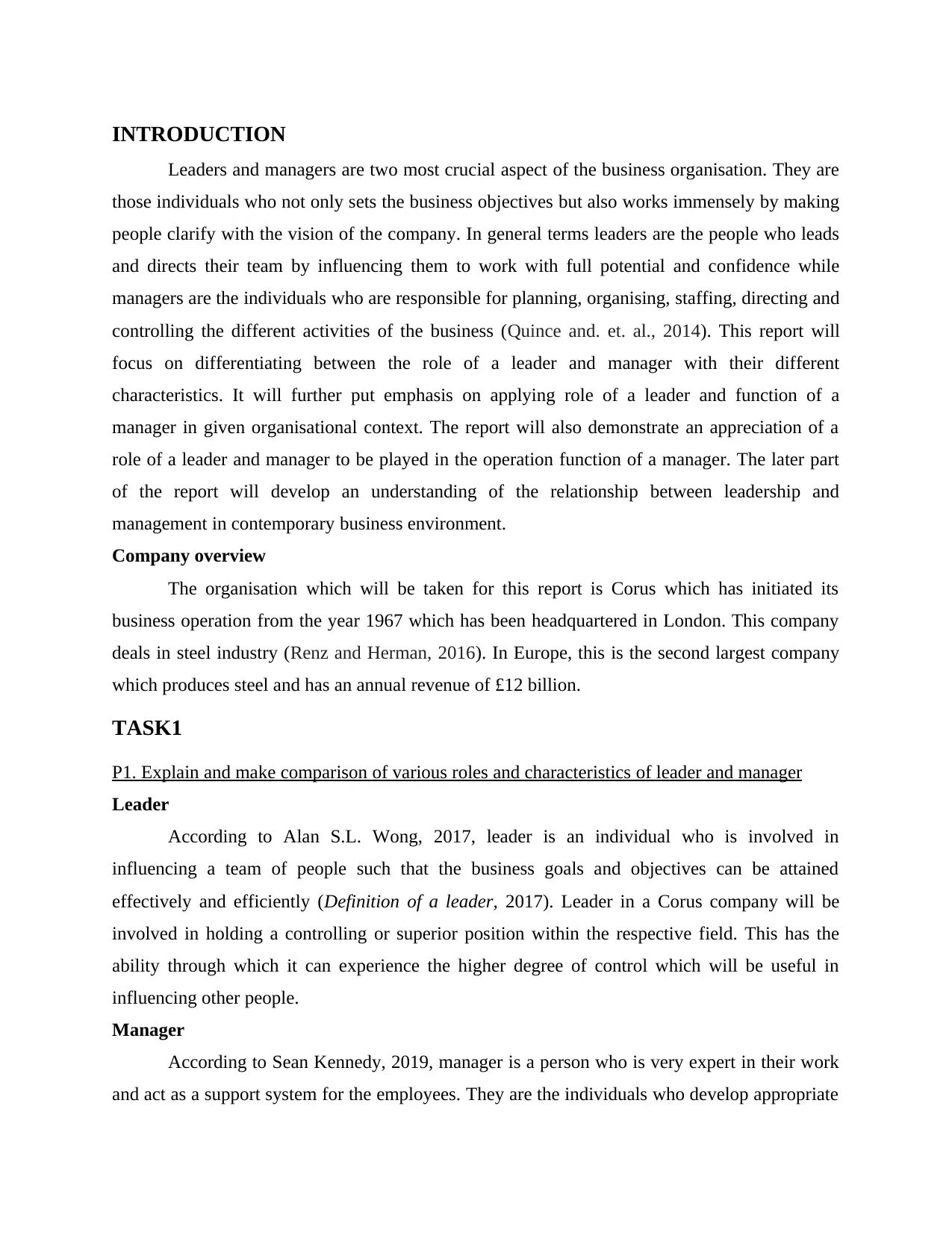
INTRODUCTION
Leaders and managers are two most crucial aspect of the business organisation. They are
those individuals who not only sets the business objectives but also works immensely by making
people clarify with the vision of the company. In general terms leaders are the people who leads
and directs their team by influencing them to work with full potential and confidence while
managers are the individuals who are responsible for planning, organising, staffing, directing and
controlling the different activities of the business (Quince and. et. al., 2014). This report will
focus on differentiating between the role of a leader and manager with their different
characteristics. It will further put emphasis on applying role of a leader and function of a
manager in given organisational context. The report will also demonstrate an appreciation of a
role of a leader and manager to be played in the operation function of a manager. The later part
of the report will develop an understanding of the relationship between leadership and
management in contemporary business environment.
Company overview
The organisation which will be taken for this report is Corus which has initiated its
business operation from the year 1967 which has been headquartered in London. This company
deals in steel industry (Renz and Herman, 2016). In Europe, this is the second largest company
which produces steel and has an annual revenue of £12 billion.
TASK1
P1. Explain and make comparison of various roles and characteristics of leader and manager
Leader
According to Alan S.L. Wong, 2017, leader is an individual who is involved in
influencing a team of people such that the business goals and objectives can be attained
effectively and efficiently (Definition of a leader, 2017). Leader in a Corus company will be
involved in holding a controlling or superior position within the respective field. This has the
ability through which it can experience the higher degree of control which will be useful in
influencing other people.
Manager
According to Sean Kennedy, 2019, manager is a person who is very expert in their work
and act as a support system for the employees. They are the individuals who develop appropriate
Leaders and managers are two most crucial aspect of the business organisation. They are
those individuals who not only sets the business objectives but also works immensely by making
people clarify with the vision of the company. In general terms leaders are the people who leads
and directs their team by influencing them to work with full potential and confidence while
managers are the individuals who are responsible for planning, organising, staffing, directing and
controlling the different activities of the business (Quince and. et. al., 2014). This report will
focus on differentiating between the role of a leader and manager with their different
characteristics. It will further put emphasis on applying role of a leader and function of a
manager in given organisational context. The report will also demonstrate an appreciation of a
role of a leader and manager to be played in the operation function of a manager. The later part
of the report will develop an understanding of the relationship between leadership and
management in contemporary business environment.
Company overview
The organisation which will be taken for this report is Corus which has initiated its
business operation from the year 1967 which has been headquartered in London. This company
deals in steel industry (Renz and Herman, 2016). In Europe, this is the second largest company
which produces steel and has an annual revenue of £12 billion.
TASK1
P1. Explain and make comparison of various roles and characteristics of leader and manager
Leader
According to Alan S.L. Wong, 2017, leader is an individual who is involved in
influencing a team of people such that the business goals and objectives can be attained
effectively and efficiently (Definition of a leader, 2017). Leader in a Corus company will be
involved in holding a controlling or superior position within the respective field. This has the
ability through which it can experience the higher degree of control which will be useful in
influencing other people.
Manager
According to Sean Kennedy, 2019, manager is a person who is very expert in their work
and act as a support system for the employees. They are the individuals who develop appropriate
⊘ This is a preview!⊘
Do you want full access?
Subscribe today to unlock all pages.

Trusted by 1+ million students worldwide
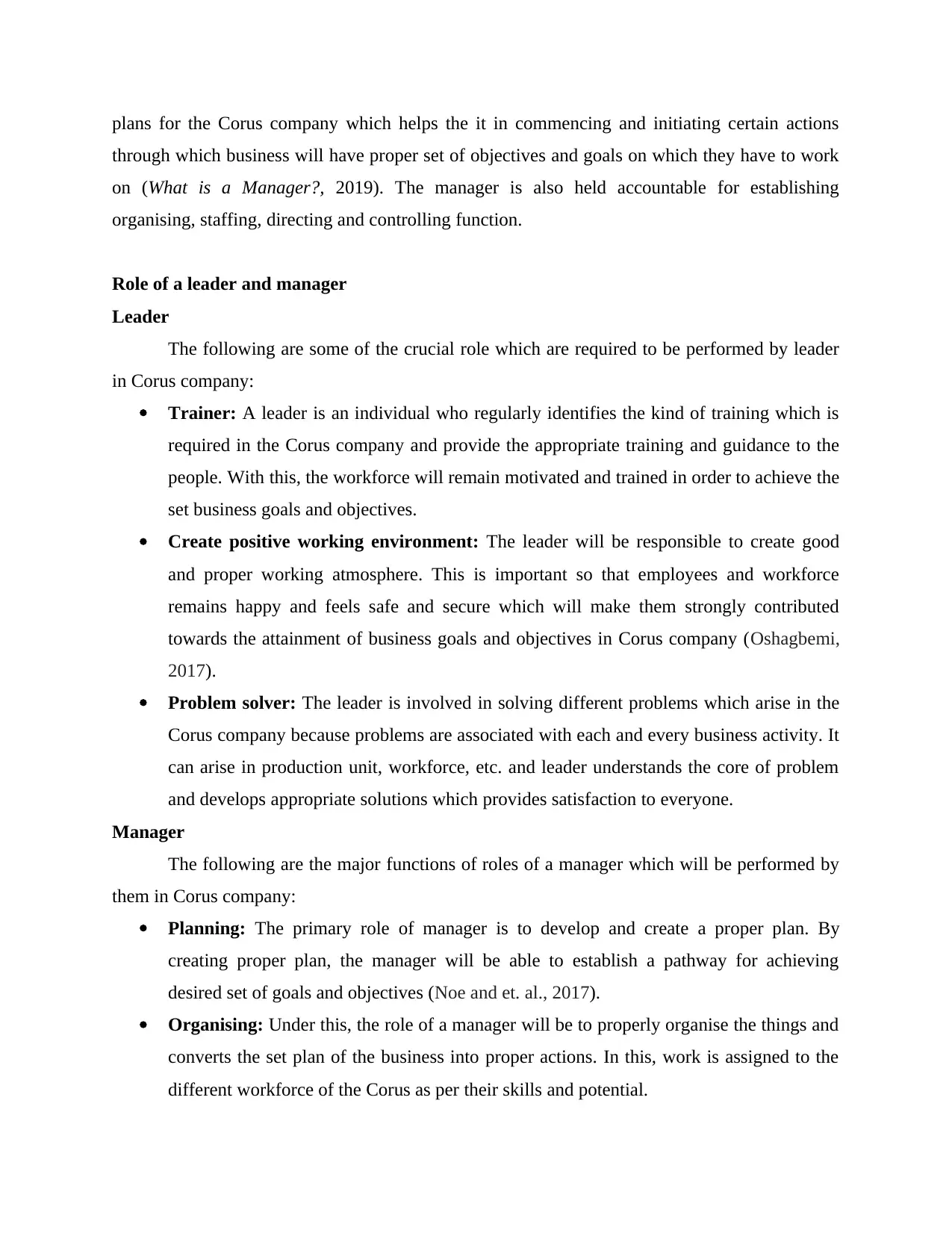
plans for the Corus company which helps the it in commencing and initiating certain actions
through which business will have proper set of objectives and goals on which they have to work
on (What is a Manager?, 2019). The manager is also held accountable for establishing
organising, staffing, directing and controlling function.
Role of a leader and manager
Leader
The following are some of the crucial role which are required to be performed by leader
in Corus company:
Trainer: A leader is an individual who regularly identifies the kind of training which is
required in the Corus company and provide the appropriate training and guidance to the
people. With this, the workforce will remain motivated and trained in order to achieve the
set business goals and objectives.
Create positive working environment: The leader will be responsible to create good
and proper working atmosphere. This is important so that employees and workforce
remains happy and feels safe and secure which will make them strongly contributed
towards the attainment of business goals and objectives in Corus company (Oshagbemi,
2017).
Problem solver: The leader is involved in solving different problems which arise in the
Corus company because problems are associated with each and every business activity. It
can arise in production unit, workforce, etc. and leader understands the core of problem
and develops appropriate solutions which provides satisfaction to everyone.
Manager
The following are the major functions of roles of a manager which will be performed by
them in Corus company:
Planning: The primary role of manager is to develop and create a proper plan. By
creating proper plan, the manager will be able to establish a pathway for achieving
desired set of goals and objectives (Noe and et. al., 2017).
Organising: Under this, the role of a manager will be to properly organise the things and
converts the set plan of the business into proper actions. In this, work is assigned to the
different workforce of the Corus as per their skills and potential.
through which business will have proper set of objectives and goals on which they have to work
on (What is a Manager?, 2019). The manager is also held accountable for establishing
organising, staffing, directing and controlling function.
Role of a leader and manager
Leader
The following are some of the crucial role which are required to be performed by leader
in Corus company:
Trainer: A leader is an individual who regularly identifies the kind of training which is
required in the Corus company and provide the appropriate training and guidance to the
people. With this, the workforce will remain motivated and trained in order to achieve the
set business goals and objectives.
Create positive working environment: The leader will be responsible to create good
and proper working atmosphere. This is important so that employees and workforce
remains happy and feels safe and secure which will make them strongly contributed
towards the attainment of business goals and objectives in Corus company (Oshagbemi,
2017).
Problem solver: The leader is involved in solving different problems which arise in the
Corus company because problems are associated with each and every business activity. It
can arise in production unit, workforce, etc. and leader understands the core of problem
and develops appropriate solutions which provides satisfaction to everyone.
Manager
The following are the major functions of roles of a manager which will be performed by
them in Corus company:
Planning: The primary role of manager is to develop and create a proper plan. By
creating proper plan, the manager will be able to establish a pathway for achieving
desired set of goals and objectives (Noe and et. al., 2017).
Organising: Under this, the role of a manager will be to properly organise the things and
converts the set plan of the business into proper actions. In this, work is assigned to the
different workforce of the Corus as per their skills and potential.
Paraphrase This Document
Need a fresh take? Get an instant paraphrase of this document with our AI Paraphraser
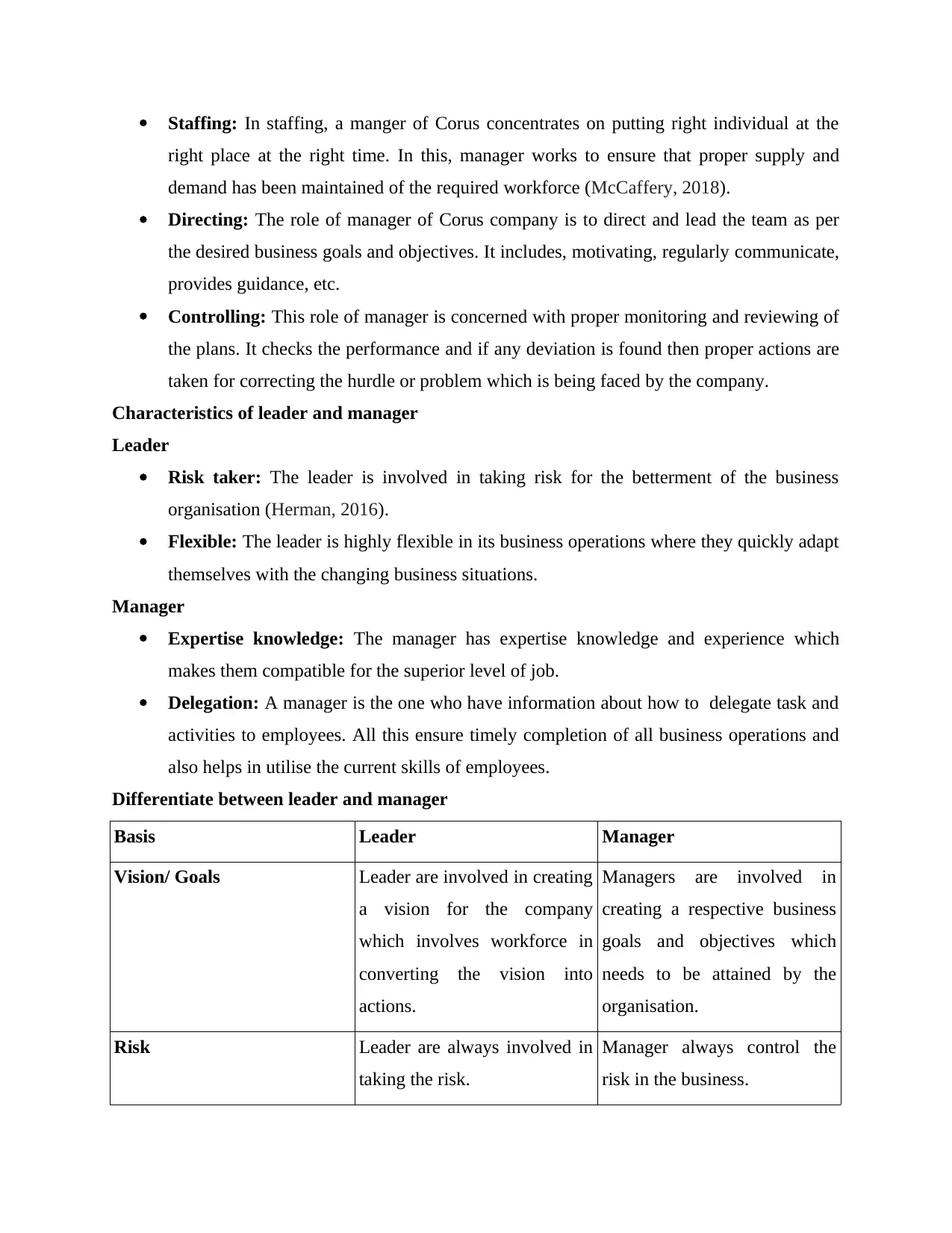
Staffing: In staffing, a manger of Corus concentrates on putting right individual at the
right place at the right time. In this, manager works to ensure that proper supply and
demand has been maintained of the required workforce (McCaffery, 2018).
Directing: The role of manager of Corus company is to direct and lead the team as per
the desired business goals and objectives. It includes, motivating, regularly communicate,
provides guidance, etc.
Controlling: This role of manager is concerned with proper monitoring and reviewing of
the plans. It checks the performance and if any deviation is found then proper actions are
taken for correcting the hurdle or problem which is being faced by the company.
Characteristics of leader and manager
Leader
Risk taker: The leader is involved in taking risk for the betterment of the business
organisation (Herman, 2016).
Flexible: The leader is highly flexible in its business operations where they quickly adapt
themselves with the changing business situations.
Manager
Expertise knowledge: The manager has expertise knowledge and experience which
makes them compatible for the superior level of job.
Delegation: A manager is the one who have information about how to delegate task and
activities to employees. All this ensure timely completion of all business operations and
also helps in utilise the current skills of employees.
Differentiate between leader and manager
Basis Leader Manager
Vision/ Goals Leader are involved in creating
a vision for the company
which involves workforce in
converting the vision into
actions.
Managers are involved in
creating a respective business
goals and objectives which
needs to be attained by the
organisation.
Risk Leader are always involved in
taking the risk.
Manager always control the
risk in the business.
right place at the right time. In this, manager works to ensure that proper supply and
demand has been maintained of the required workforce (McCaffery, 2018).
Directing: The role of manager of Corus company is to direct and lead the team as per
the desired business goals and objectives. It includes, motivating, regularly communicate,
provides guidance, etc.
Controlling: This role of manager is concerned with proper monitoring and reviewing of
the plans. It checks the performance and if any deviation is found then proper actions are
taken for correcting the hurdle or problem which is being faced by the company.
Characteristics of leader and manager
Leader
Risk taker: The leader is involved in taking risk for the betterment of the business
organisation (Herman, 2016).
Flexible: The leader is highly flexible in its business operations where they quickly adapt
themselves with the changing business situations.
Manager
Expertise knowledge: The manager has expertise knowledge and experience which
makes them compatible for the superior level of job.
Delegation: A manager is the one who have information about how to delegate task and
activities to employees. All this ensure timely completion of all business operations and
also helps in utilise the current skills of employees.
Differentiate between leader and manager
Basis Leader Manager
Vision/ Goals Leader are involved in creating
a vision for the company
which involves workforce in
converting the vision into
actions.
Managers are involved in
creating a respective business
goals and objectives which
needs to be attained by the
organisation.
Risk Leader are always involved in
taking the risk.
Manager always control the
risk in the business.
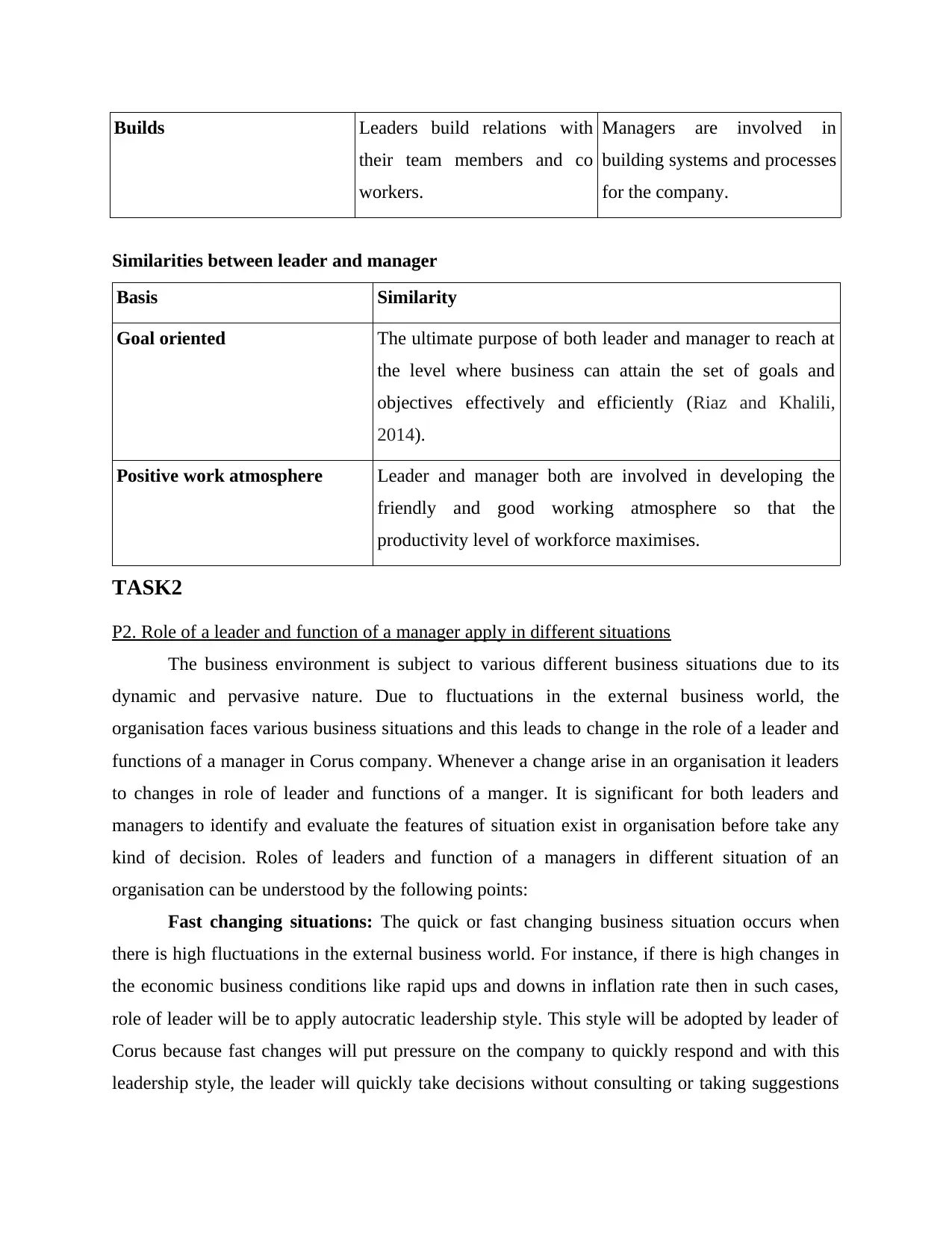
Builds Leaders build relations with
their team members and co
workers.
Managers are involved in
building systems and processes
for the company.
Similarities between leader and manager
Basis Similarity
Goal oriented The ultimate purpose of both leader and manager to reach at
the level where business can attain the set of goals and
objectives effectively and efficiently (Riaz and Khalili,
2014).
Positive work atmosphere Leader and manager both are involved in developing the
friendly and good working atmosphere so that the
productivity level of workforce maximises.
TASK2
P2. Role of a leader and function of a manager apply in different situations
The business environment is subject to various different business situations due to its
dynamic and pervasive nature. Due to fluctuations in the external business world, the
organisation faces various business situations and this leads to change in the role of a leader and
functions of a manager in Corus company. Whenever a change arise in an organisation it leaders
to changes in role of leader and functions of a manger. It is significant for both leaders and
managers to identify and evaluate the features of situation exist in organisation before take any
kind of decision. Roles of leaders and function of a managers in different situation of an
organisation can be understood by the following points:
Fast changing situations: The quick or fast changing business situation occurs when
there is high fluctuations in the external business world. For instance, if there is high changes in
the economic business conditions like rapid ups and downs in inflation rate then in such cases,
role of leader will be to apply autocratic leadership style. This style will be adopted by leader of
Corus because fast changes will put pressure on the company to quickly respond and with this
leadership style, the leader will quickly take decisions without consulting or taking suggestions
their team members and co
workers.
Managers are involved in
building systems and processes
for the company.
Similarities between leader and manager
Basis Similarity
Goal oriented The ultimate purpose of both leader and manager to reach at
the level where business can attain the set of goals and
objectives effectively and efficiently (Riaz and Khalili,
2014).
Positive work atmosphere Leader and manager both are involved in developing the
friendly and good working atmosphere so that the
productivity level of workforce maximises.
TASK2
P2. Role of a leader and function of a manager apply in different situations
The business environment is subject to various different business situations due to its
dynamic and pervasive nature. Due to fluctuations in the external business world, the
organisation faces various business situations and this leads to change in the role of a leader and
functions of a manager in Corus company. Whenever a change arise in an organisation it leaders
to changes in role of leader and functions of a manger. It is significant for both leaders and
managers to identify and evaluate the features of situation exist in organisation before take any
kind of decision. Roles of leaders and function of a managers in different situation of an
organisation can be understood by the following points:
Fast changing situations: The quick or fast changing business situation occurs when
there is high fluctuations in the external business world. For instance, if there is high changes in
the economic business conditions like rapid ups and downs in inflation rate then in such cases,
role of leader will be to apply autocratic leadership style. This style will be adopted by leader of
Corus because fast changes will put pressure on the company to quickly respond and with this
leadership style, the leader will quickly take decisions without consulting or taking suggestions
⊘ This is a preview!⊘
Do you want full access?
Subscribe today to unlock all pages.

Trusted by 1+ million students worldwide
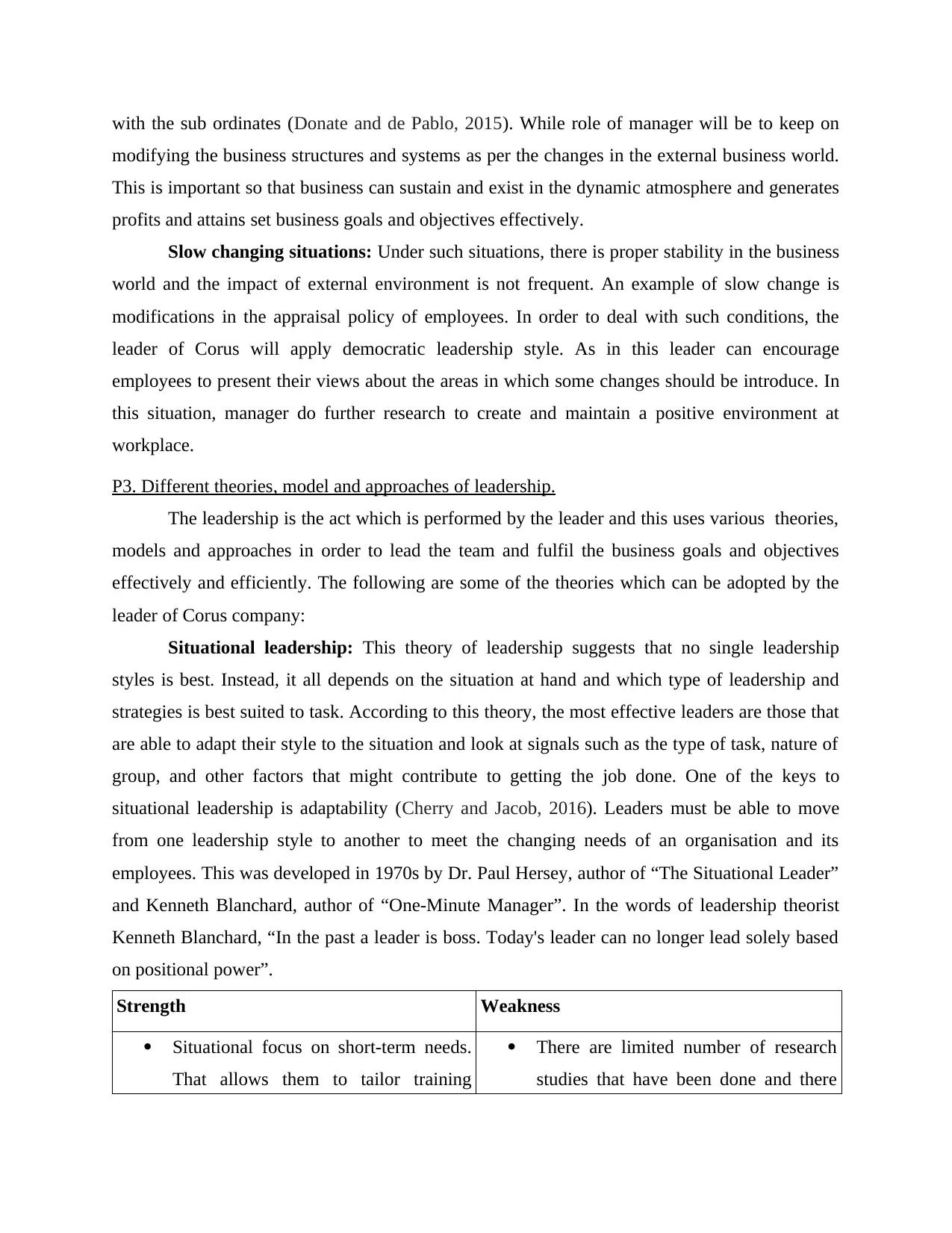
with the sub ordinates (Donate and de Pablo, 2015). While role of manager will be to keep on
modifying the business structures and systems as per the changes in the external business world.
This is important so that business can sustain and exist in the dynamic atmosphere and generates
profits and attains set business goals and objectives effectively.
Slow changing situations: Under such situations, there is proper stability in the business
world and the impact of external environment is not frequent. An example of slow change is
modifications in the appraisal policy of employees. In order to deal with such conditions, the
leader of Corus will apply democratic leadership style. As in this leader can encourage
employees to present their views about the areas in which some changes should be introduce. In
this situation, manager do further research to create and maintain a positive environment at
workplace.
P3. Different theories, model and approaches of leadership.
The leadership is the act which is performed by the leader and this uses various theories,
models and approaches in order to lead the team and fulfil the business goals and objectives
effectively and efficiently. The following are some of the theories which can be adopted by the
leader of Corus company:
Situational leadership: This theory of leadership suggests that no single leadership
styles is best. Instead, it all depends on the situation at hand and which type of leadership and
strategies is best suited to task. According to this theory, the most effective leaders are those that
are able to adapt their style to the situation and look at signals such as the type of task, nature of
group, and other factors that might contribute to getting the job done. One of the keys to
situational leadership is adaptability (Cherry and Jacob, 2016). Leaders must be able to move
from one leadership style to another to meet the changing needs of an organisation and its
employees. This was developed in 1970s by Dr. Paul Hersey, author of “The Situational Leader”
and Kenneth Blanchard, author of “One-Minute Manager”. In the words of leadership theorist
Kenneth Blanchard, “In the past a leader is boss. Today's leader can no longer lead solely based
on positional power”.
Strength Weakness
Situational focus on short-term needs.
That allows them to tailor training
There are limited number of research
studies that have been done and there
modifying the business structures and systems as per the changes in the external business world.
This is important so that business can sustain and exist in the dynamic atmosphere and generates
profits and attains set business goals and objectives effectively.
Slow changing situations: Under such situations, there is proper stability in the business
world and the impact of external environment is not frequent. An example of slow change is
modifications in the appraisal policy of employees. In order to deal with such conditions, the
leader of Corus will apply democratic leadership style. As in this leader can encourage
employees to present their views about the areas in which some changes should be introduce. In
this situation, manager do further research to create and maintain a positive environment at
workplace.
P3. Different theories, model and approaches of leadership.
The leadership is the act which is performed by the leader and this uses various theories,
models and approaches in order to lead the team and fulfil the business goals and objectives
effectively and efficiently. The following are some of the theories which can be adopted by the
leader of Corus company:
Situational leadership: This theory of leadership suggests that no single leadership
styles is best. Instead, it all depends on the situation at hand and which type of leadership and
strategies is best suited to task. According to this theory, the most effective leaders are those that
are able to adapt their style to the situation and look at signals such as the type of task, nature of
group, and other factors that might contribute to getting the job done. One of the keys to
situational leadership is adaptability (Cherry and Jacob, 2016). Leaders must be able to move
from one leadership style to another to meet the changing needs of an organisation and its
employees. This was developed in 1970s by Dr. Paul Hersey, author of “The Situational Leader”
and Kenneth Blanchard, author of “One-Minute Manager”. In the words of leadership theorist
Kenneth Blanchard, “In the past a leader is boss. Today's leader can no longer lead solely based
on positional power”.
Strength Weakness
Situational focus on short-term needs.
That allows them to tailor training
There are limited number of research
studies that have been done and there
Paraphrase This Document
Need a fresh take? Get an instant paraphrase of this document with our AI Paraphraser
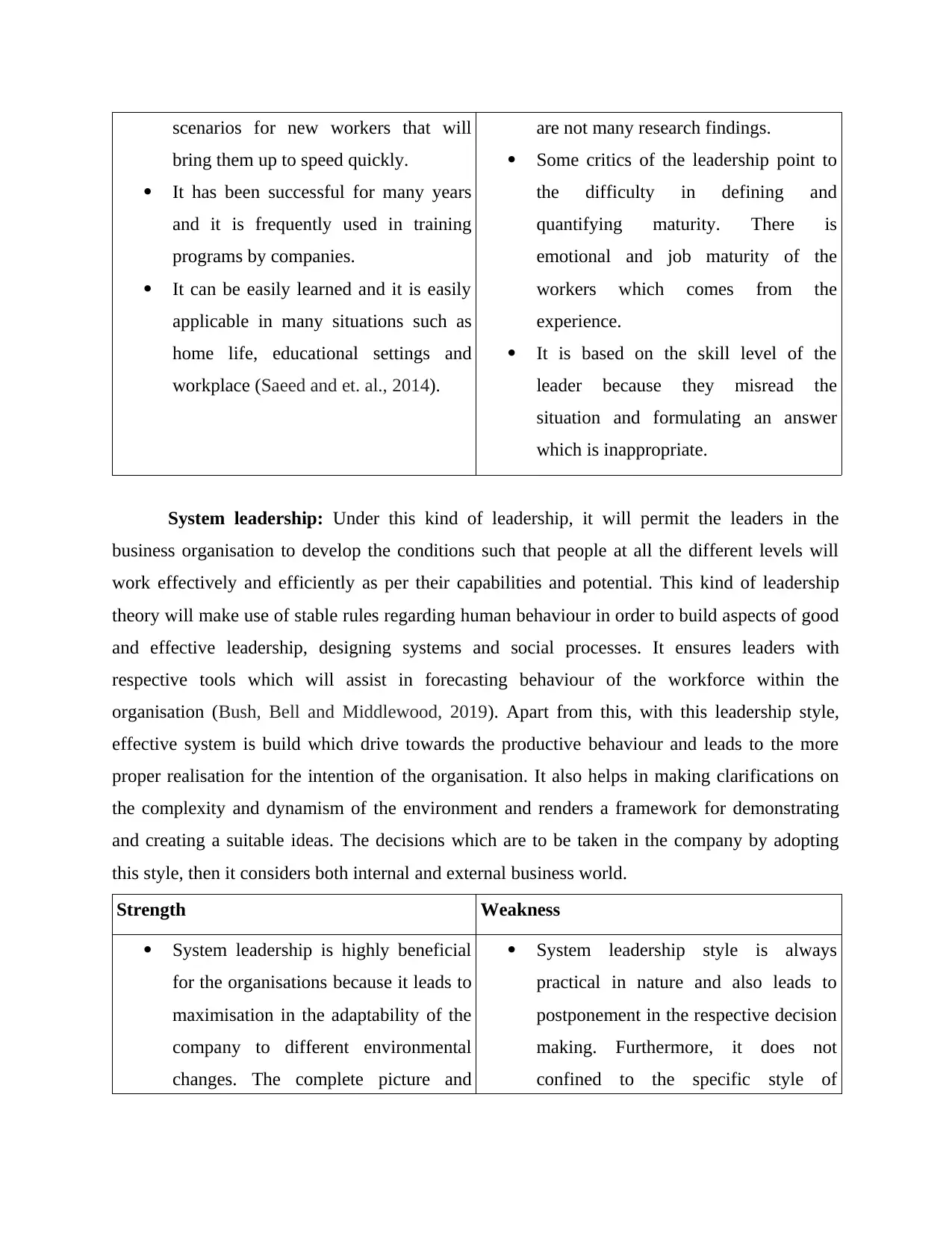
scenarios for new workers that will
bring them up to speed quickly.
It has been successful for many years
and it is frequently used in training
programs by companies.
It can be easily learned and it is easily
applicable in many situations such as
home life, educational settings and
workplace (Saeed and et. al., 2014).
are not many research findings.
Some critics of the leadership point to
the difficulty in defining and
quantifying maturity. There is
emotional and job maturity of the
workers which comes from the
experience.
It is based on the skill level of the
leader because they misread the
situation and formulating an answer
which is inappropriate.
System leadership: Under this kind of leadership, it will permit the leaders in the
business organisation to develop the conditions such that people at all the different levels will
work effectively and efficiently as per their capabilities and potential. This kind of leadership
theory will make use of stable rules regarding human behaviour in order to build aspects of good
and effective leadership, designing systems and social processes. It ensures leaders with
respective tools which will assist in forecasting behaviour of the workforce within the
organisation (Bush, Bell and Middlewood, 2019). Apart from this, with this leadership style,
effective system is build which drive towards the productive behaviour and leads to the more
proper realisation for the intention of the organisation. It also helps in making clarifications on
the complexity and dynamism of the environment and renders a framework for demonstrating
and creating a suitable ideas. The decisions which are to be taken in the company by adopting
this style, then it considers both internal and external business world.
Strength Weakness
System leadership is highly beneficial
for the organisations because it leads to
maximisation in the adaptability of the
company to different environmental
changes. The complete picture and
System leadership style is always
practical in nature and also leads to
postponement in the respective decision
making. Furthermore, it does not
confined to the specific style of
bring them up to speed quickly.
It has been successful for many years
and it is frequently used in training
programs by companies.
It can be easily learned and it is easily
applicable in many situations such as
home life, educational settings and
workplace (Saeed and et. al., 2014).
are not many research findings.
Some critics of the leadership point to
the difficulty in defining and
quantifying maturity. There is
emotional and job maturity of the
workers which comes from the
experience.
It is based on the skill level of the
leader because they misread the
situation and formulating an answer
which is inappropriate.
System leadership: Under this kind of leadership, it will permit the leaders in the
business organisation to develop the conditions such that people at all the different levels will
work effectively and efficiently as per their capabilities and potential. This kind of leadership
theory will make use of stable rules regarding human behaviour in order to build aspects of good
and effective leadership, designing systems and social processes. It ensures leaders with
respective tools which will assist in forecasting behaviour of the workforce within the
organisation (Bush, Bell and Middlewood, 2019). Apart from this, with this leadership style,
effective system is build which drive towards the productive behaviour and leads to the more
proper realisation for the intention of the organisation. It also helps in making clarifications on
the complexity and dynamism of the environment and renders a framework for demonstrating
and creating a suitable ideas. The decisions which are to be taken in the company by adopting
this style, then it considers both internal and external business world.
Strength Weakness
System leadership is highly beneficial
for the organisations because it leads to
maximisation in the adaptability of the
company to different environmental
changes. The complete picture and
System leadership style is always
practical in nature and also leads to
postponement in the respective decision
making. Furthermore, it does not
confined to the specific style of
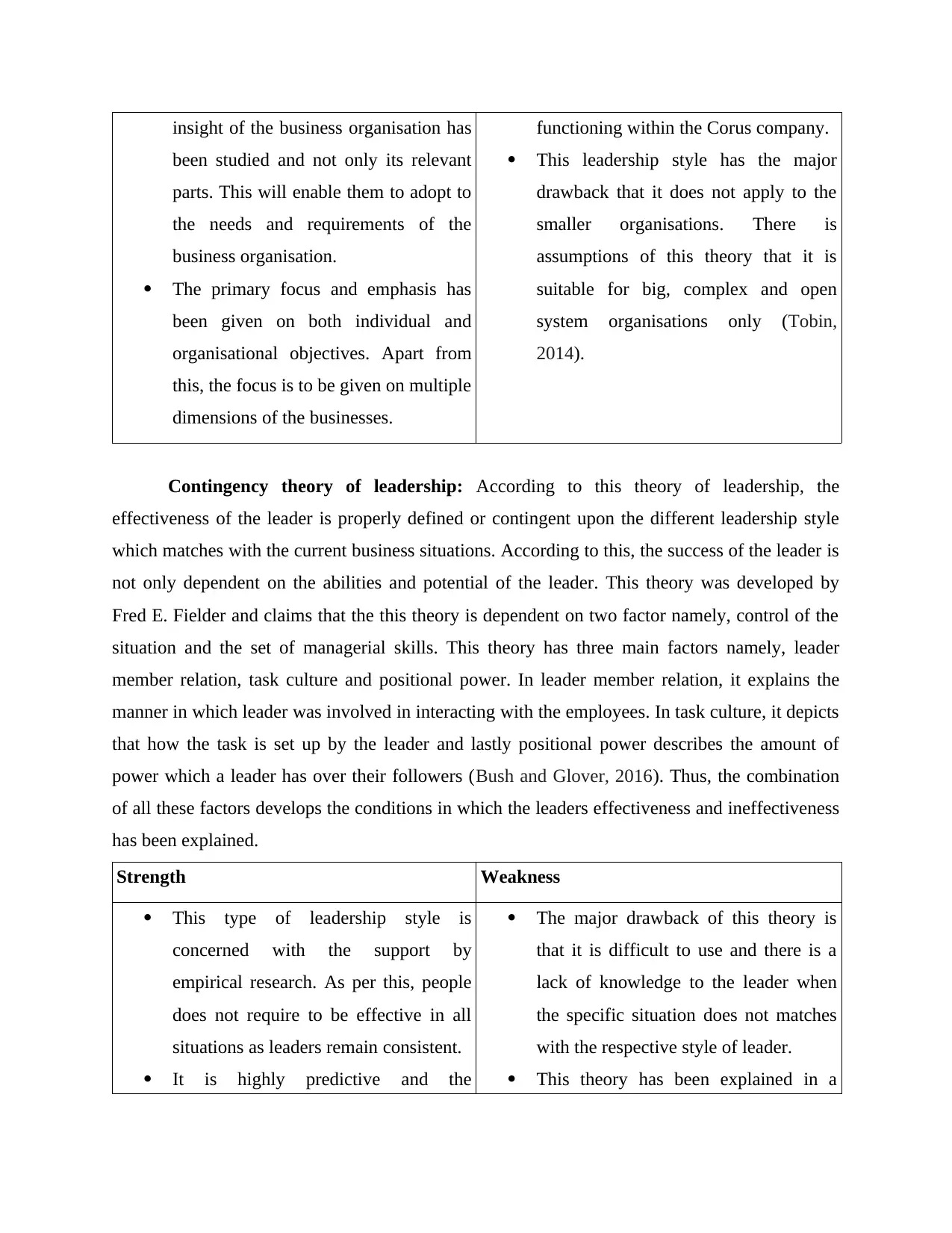
insight of the business organisation has
been studied and not only its relevant
parts. This will enable them to adopt to
the needs and requirements of the
business organisation.
The primary focus and emphasis has
been given on both individual and
organisational objectives. Apart from
this, the focus is to be given on multiple
dimensions of the businesses.
functioning within the Corus company.
This leadership style has the major
drawback that it does not apply to the
smaller organisations. There is
assumptions of this theory that it is
suitable for big, complex and open
system organisations only (Tobin,
2014).
Contingency theory of leadership: According to this theory of leadership, the
effectiveness of the leader is properly defined or contingent upon the different leadership style
which matches with the current business situations. According to this, the success of the leader is
not only dependent on the abilities and potential of the leader. This theory was developed by
Fred E. Fielder and claims that the this theory is dependent on two factor namely, control of the
situation and the set of managerial skills. This theory has three main factors namely, leader
member relation, task culture and positional power. In leader member relation, it explains the
manner in which leader was involved in interacting with the employees. In task culture, it depicts
that how the task is set up by the leader and lastly positional power describes the amount of
power which a leader has over their followers (Bush and Glover, 2016). Thus, the combination
of all these factors develops the conditions in which the leaders effectiveness and ineffectiveness
has been explained.
Strength Weakness
This type of leadership style is
concerned with the support by
empirical research. As per this, people
does not require to be effective in all
situations as leaders remain consistent.
It is highly predictive and the
The major drawback of this theory is
that it is difficult to use and there is a
lack of knowledge to the leader when
the specific situation does not matches
with the respective style of leader.
This theory has been explained in a
been studied and not only its relevant
parts. This will enable them to adopt to
the needs and requirements of the
business organisation.
The primary focus and emphasis has
been given on both individual and
organisational objectives. Apart from
this, the focus is to be given on multiple
dimensions of the businesses.
functioning within the Corus company.
This leadership style has the major
drawback that it does not apply to the
smaller organisations. There is
assumptions of this theory that it is
suitable for big, complex and open
system organisations only (Tobin,
2014).
Contingency theory of leadership: According to this theory of leadership, the
effectiveness of the leader is properly defined or contingent upon the different leadership style
which matches with the current business situations. According to this, the success of the leader is
not only dependent on the abilities and potential of the leader. This theory was developed by
Fred E. Fielder and claims that the this theory is dependent on two factor namely, control of the
situation and the set of managerial skills. This theory has three main factors namely, leader
member relation, task culture and positional power. In leader member relation, it explains the
manner in which leader was involved in interacting with the employees. In task culture, it depicts
that how the task is set up by the leader and lastly positional power describes the amount of
power which a leader has over their followers (Bush and Glover, 2016). Thus, the combination
of all these factors develops the conditions in which the leaders effectiveness and ineffectiveness
has been explained.
Strength Weakness
This type of leadership style is
concerned with the support by
empirical research. As per this, people
does not require to be effective in all
situations as leaders remain consistent.
It is highly predictive and the
The major drawback of this theory is
that it is difficult to use and there is a
lack of knowledge to the leader when
the specific situation does not matches
with the respective style of leader.
This theory has been explained in a
⊘ This is a preview!⊘
Do you want full access?
Subscribe today to unlock all pages.

Trusted by 1+ million students worldwide
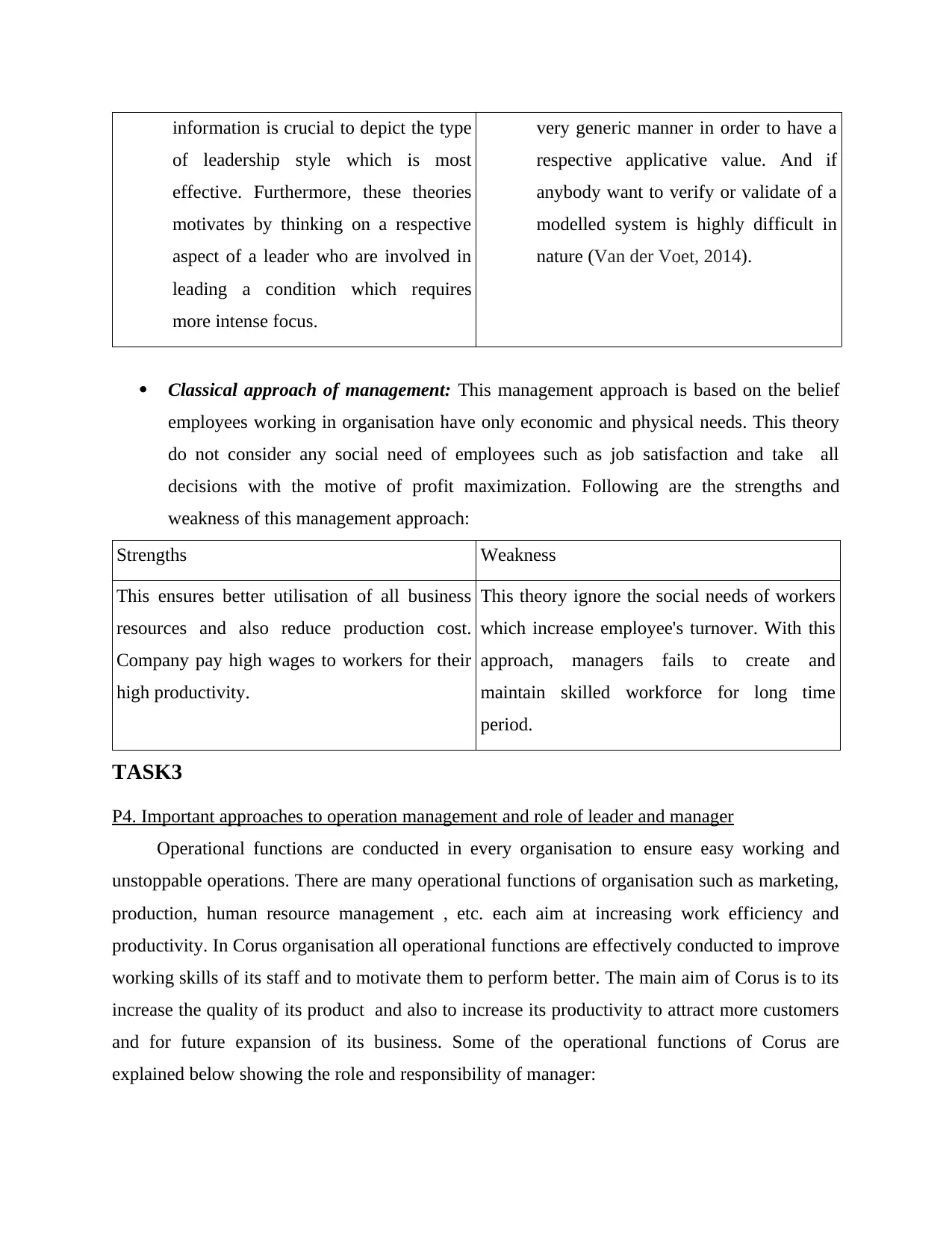
information is crucial to depict the type
of leadership style which is most
effective. Furthermore, these theories
motivates by thinking on a respective
aspect of a leader who are involved in
leading a condition which requires
more intense focus.
very generic manner in order to have a
respective applicative value. And if
anybody want to verify or validate of a
modelled system is highly difficult in
nature (Van der Voet, 2014).
Classical approach of management: This management approach is based on the belief
employees working in organisation have only economic and physical needs. This theory
do not consider any social need of employees such as job satisfaction and take all
decisions with the motive of profit maximization. Following are the strengths and
weakness of this management approach:
Strengths Weakness
This ensures better utilisation of all business
resources and also reduce production cost.
Company pay high wages to workers for their
high productivity.
This theory ignore the social needs of workers
which increase employee's turnover. With this
approach, managers fails to create and
maintain skilled workforce for long time
period.
TASK3
P4. Important approaches to operation management and role of leader and manager
Operational functions are conducted in every organisation to ensure easy working and
unstoppable operations. There are many operational functions of organisation such as marketing,
production, human resource management , etc. each aim at increasing work efficiency and
productivity. In Corus organisation all operational functions are effectively conducted to improve
working skills of its staff and to motivate them to perform better. The main aim of Corus is to its
increase the quality of its product and also to increase its productivity to attract more customers
and for future expansion of its business. Some of the operational functions of Corus are
explained below showing the role and responsibility of manager:
of leadership style which is most
effective. Furthermore, these theories
motivates by thinking on a respective
aspect of a leader who are involved in
leading a condition which requires
more intense focus.
very generic manner in order to have a
respective applicative value. And if
anybody want to verify or validate of a
modelled system is highly difficult in
nature (Van der Voet, 2014).
Classical approach of management: This management approach is based on the belief
employees working in organisation have only economic and physical needs. This theory
do not consider any social need of employees such as job satisfaction and take all
decisions with the motive of profit maximization. Following are the strengths and
weakness of this management approach:
Strengths Weakness
This ensures better utilisation of all business
resources and also reduce production cost.
Company pay high wages to workers for their
high productivity.
This theory ignore the social needs of workers
which increase employee's turnover. With this
approach, managers fails to create and
maintain skilled workforce for long time
period.
TASK3
P4. Important approaches to operation management and role of leader and manager
Operational functions are conducted in every organisation to ensure easy working and
unstoppable operations. There are many operational functions of organisation such as marketing,
production, human resource management , etc. each aim at increasing work efficiency and
productivity. In Corus organisation all operational functions are effectively conducted to improve
working skills of its staff and to motivate them to perform better. The main aim of Corus is to its
increase the quality of its product and also to increase its productivity to attract more customers
and for future expansion of its business. Some of the operational functions of Corus are
explained below showing the role and responsibility of manager:
Paraphrase This Document
Need a fresh take? Get an instant paraphrase of this document with our AI Paraphraser
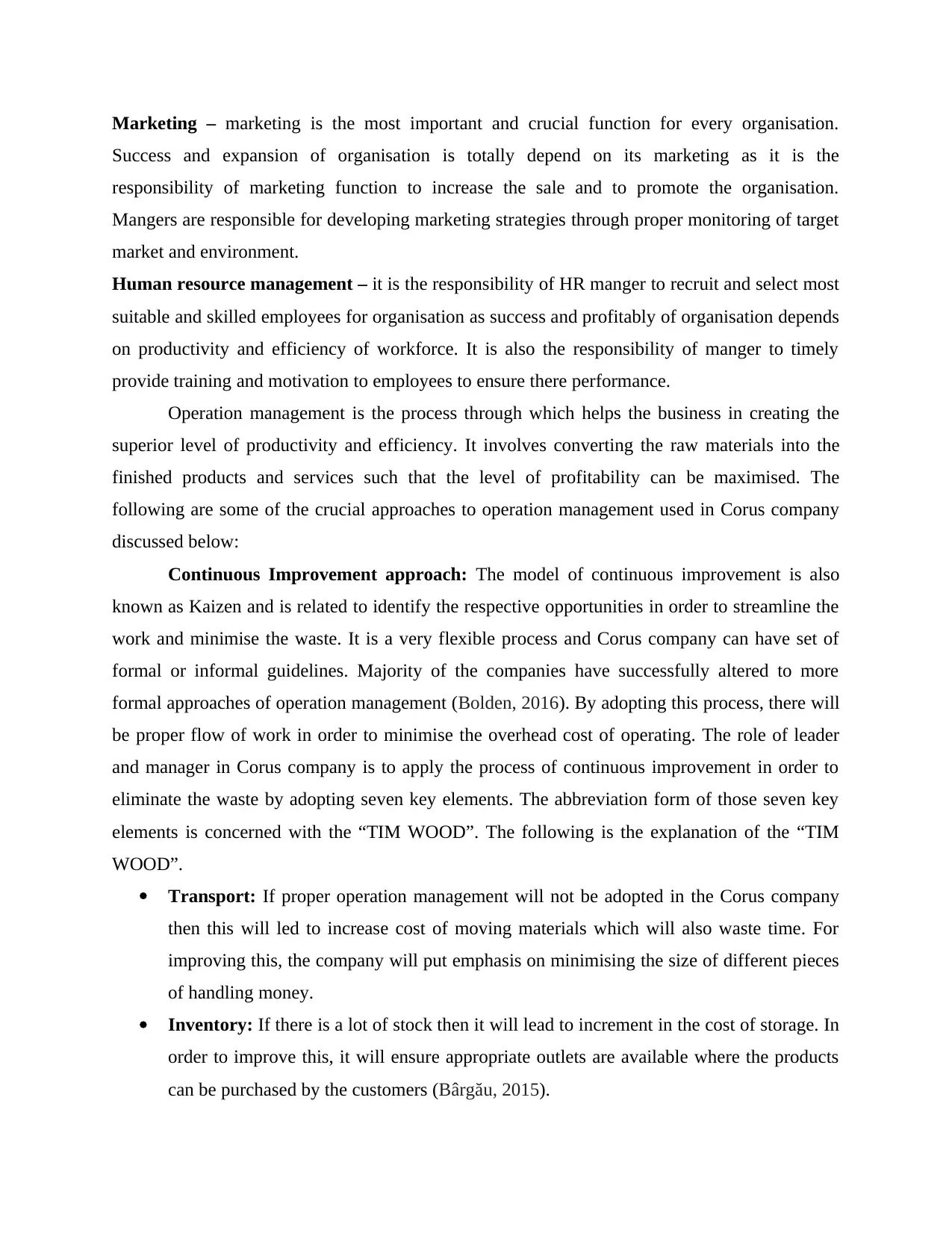
Marketing – marketing is the most important and crucial function for every organisation.
Success and expansion of organisation is totally depend on its marketing as it is the
responsibility of marketing function to increase the sale and to promote the organisation.
Mangers are responsible for developing marketing strategies through proper monitoring of target
market and environment.
Human resource management – it is the responsibility of HR manger to recruit and select most
suitable and skilled employees for organisation as success and profitably of organisation depends
on productivity and efficiency of workforce. It is also the responsibility of manger to timely
provide training and motivation to employees to ensure there performance.
Operation management is the process through which helps the business in creating the
superior level of productivity and efficiency. It involves converting the raw materials into the
finished products and services such that the level of profitability can be maximised. The
following are some of the crucial approaches to operation management used in Corus company
discussed below:
Continuous Improvement approach: The model of continuous improvement is also
known as Kaizen and is related to identify the respective opportunities in order to streamline the
work and minimise the waste. It is a very flexible process and Corus company can have set of
formal or informal guidelines. Majority of the companies have successfully altered to more
formal approaches of operation management (Bolden, 2016). By adopting this process, there will
be proper flow of work in order to minimise the overhead cost of operating. The role of leader
and manager in Corus company is to apply the process of continuous improvement in order to
eliminate the waste by adopting seven key elements. The abbreviation form of those seven key
elements is concerned with the “TIM WOOD”. The following is the explanation of the “TIM
WOOD”.
Transport: If proper operation management will not be adopted in the Corus company
then this will led to increase cost of moving materials which will also waste time. For
improving this, the company will put emphasis on minimising the size of different pieces
of handling money.
Inventory: If there is a lot of stock then it will lead to increment in the cost of storage. In
order to improve this, it will ensure appropriate outlets are available where the products
can be purchased by the customers (Bârgău, 2015).
Success and expansion of organisation is totally depend on its marketing as it is the
responsibility of marketing function to increase the sale and to promote the organisation.
Mangers are responsible for developing marketing strategies through proper monitoring of target
market and environment.
Human resource management – it is the responsibility of HR manger to recruit and select most
suitable and skilled employees for organisation as success and profitably of organisation depends
on productivity and efficiency of workforce. It is also the responsibility of manger to timely
provide training and motivation to employees to ensure there performance.
Operation management is the process through which helps the business in creating the
superior level of productivity and efficiency. It involves converting the raw materials into the
finished products and services such that the level of profitability can be maximised. The
following are some of the crucial approaches to operation management used in Corus company
discussed below:
Continuous Improvement approach: The model of continuous improvement is also
known as Kaizen and is related to identify the respective opportunities in order to streamline the
work and minimise the waste. It is a very flexible process and Corus company can have set of
formal or informal guidelines. Majority of the companies have successfully altered to more
formal approaches of operation management (Bolden, 2016). By adopting this process, there will
be proper flow of work in order to minimise the overhead cost of operating. The role of leader
and manager in Corus company is to apply the process of continuous improvement in order to
eliminate the waste by adopting seven key elements. The abbreviation form of those seven key
elements is concerned with the “TIM WOOD”. The following is the explanation of the “TIM
WOOD”.
Transport: If proper operation management will not be adopted in the Corus company
then this will led to increase cost of moving materials which will also waste time. For
improving this, the company will put emphasis on minimising the size of different pieces
of handling money.
Inventory: If there is a lot of stock then it will lead to increment in the cost of storage. In
order to improve this, it will ensure appropriate outlets are available where the products
can be purchased by the customers (Bârgău, 2015).
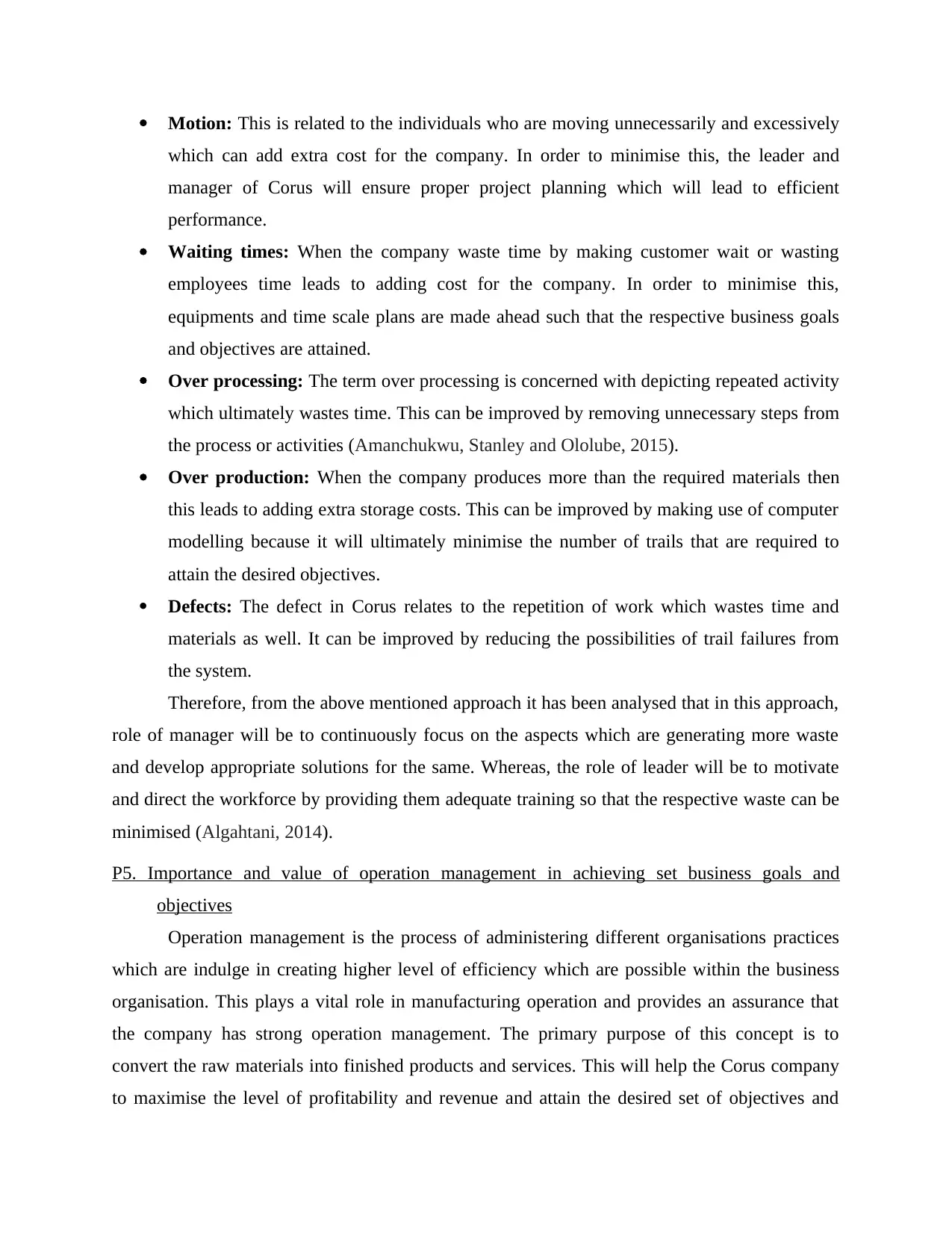
Motion: This is related to the individuals who are moving unnecessarily and excessively
which can add extra cost for the company. In order to minimise this, the leader and
manager of Corus will ensure proper project planning which will lead to efficient
performance.
Waiting times: When the company waste time by making customer wait or wasting
employees time leads to adding cost for the company. In order to minimise this,
equipments and time scale plans are made ahead such that the respective business goals
and objectives are attained.
Over processing: The term over processing is concerned with depicting repeated activity
which ultimately wastes time. This can be improved by removing unnecessary steps from
the process or activities (Amanchukwu, Stanley and Ololube, 2015).
Over production: When the company produces more than the required materials then
this leads to adding extra storage costs. This can be improved by making use of computer
modelling because it will ultimately minimise the number of trails that are required to
attain the desired objectives.
Defects: The defect in Corus relates to the repetition of work which wastes time and
materials as well. It can be improved by reducing the possibilities of trail failures from
the system.
Therefore, from the above mentioned approach it has been analysed that in this approach,
role of manager will be to continuously focus on the aspects which are generating more waste
and develop appropriate solutions for the same. Whereas, the role of leader will be to motivate
and direct the workforce by providing them adequate training so that the respective waste can be
minimised (Algahtani, 2014).
P5. Importance and value of operation management in achieving set business goals and
objectives
Operation management is the process of administering different organisations practices
which are indulge in creating higher level of efficiency which are possible within the business
organisation. This plays a vital role in manufacturing operation and provides an assurance that
the company has strong operation management. The primary purpose of this concept is to
convert the raw materials into finished products and services. This will help the Corus company
to maximise the level of profitability and revenue and attain the desired set of objectives and
which can add extra cost for the company. In order to minimise this, the leader and
manager of Corus will ensure proper project planning which will lead to efficient
performance.
Waiting times: When the company waste time by making customer wait or wasting
employees time leads to adding cost for the company. In order to minimise this,
equipments and time scale plans are made ahead such that the respective business goals
and objectives are attained.
Over processing: The term over processing is concerned with depicting repeated activity
which ultimately wastes time. This can be improved by removing unnecessary steps from
the process or activities (Amanchukwu, Stanley and Ololube, 2015).
Over production: When the company produces more than the required materials then
this leads to adding extra storage costs. This can be improved by making use of computer
modelling because it will ultimately minimise the number of trails that are required to
attain the desired objectives.
Defects: The defect in Corus relates to the repetition of work which wastes time and
materials as well. It can be improved by reducing the possibilities of trail failures from
the system.
Therefore, from the above mentioned approach it has been analysed that in this approach,
role of manager will be to continuously focus on the aspects which are generating more waste
and develop appropriate solutions for the same. Whereas, the role of leader will be to motivate
and direct the workforce by providing them adequate training so that the respective waste can be
minimised (Algahtani, 2014).
P5. Importance and value of operation management in achieving set business goals and
objectives
Operation management is the process of administering different organisations practices
which are indulge in creating higher level of efficiency which are possible within the business
organisation. This plays a vital role in manufacturing operation and provides an assurance that
the company has strong operation management. The primary purpose of this concept is to
convert the raw materials into finished products and services. This will help the Corus company
to maximise the level of profitability and revenue and attain the desired set of objectives and
⊘ This is a preview!⊘
Do you want full access?
Subscribe today to unlock all pages.

Trusted by 1+ million students worldwide
1 out of 17
Related Documents
Your All-in-One AI-Powered Toolkit for Academic Success.
+13062052269
info@desklib.com
Available 24*7 on WhatsApp / Email
![[object Object]](/_next/static/media/star-bottom.7253800d.svg)
Unlock your academic potential
Copyright © 2020–2025 A2Z Services. All Rights Reserved. Developed and managed by ZUCOL.





